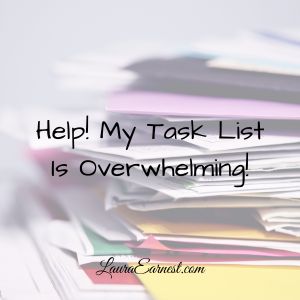I do three different types of planning in order to keep myself on track and productive: daily, weekly and long-term. This month we will be looking at all three. We’ll start with what I consider the most important for my productivity: the weekly plan.
When I first purchased my first planner, I didn’t know anything about planning. And the system didn’t educate me either. I had a 2 page per day Daytimer, and the instructions were just about how to plan a day. I was in college at the time, and I could never figure out how I always had so much left to do at the end of each day!
The problem for me, as most people I have talked to, is that the schedule is not constant. Some days are busier than others. And yet we never step back and take that into account.
Why I Don’t Do A Review
Getting Things Done introduced me to a weekly plan – called the weekly review – and it was all about getting yourself reset. Get your in-boxes empty, empty your head, and process the paper. Then you review the lists – all of them – and bring them up to date to be worked on.
I believe the idea is that you hit your work week all primed and ready to go on the tasks at hand. No outstanding stuff nagging at you. It seems to me to be a way to make sure you haven’t missed anything in the overwhelming overhead that it takes to do Getting Things Done.
Even when I followed these instructions, I still didn’t have a handle on my week. I still had too many days where I was busy and couldn’t get things done, and too many Fridays where my task list was still alarmingly long.
And so I developed my weekly planning routine.
Looking Back
The first thing I do is look back over the past week. This serves two purposes:
I see what I have done. It’s important for me to acknowledge how much I accomplish during a week. Otherwise I end up in a constant mental state of frantic “I’m not getting enough done.” I look at my calendar, and then look at how much I got done on both the busy days and the not-so-busy days. I give myself a minute to sit with all the accomplished projects and tasks
I see what has come out of the last week. Rarely do projects come out of a vacuum. They are always tangentially related to something else. This past week had the following:
- The worship services committee met at church. This was our first meeting since the stay-at-home order, and we discussed the changes to the service, as well as where it could be expanded or changed.
- During that meeting, it became apparent to the minister that I have skills with technology that could be put to use. She asked me to attend a meeting of the local church cluster to learn about what other churches in our denomination were doing to handle suddenly having to do services over the internet. So I added a meeting to my calendar as a result of reviewing the notes from the meeting.
- After the meeting, I would have to report back to the rest of the committee. I made a task to write up my notes and send them out the day following the meeting.
Each week as I review my bullet journal, I see the places where I have items to follow up. I add these to either my calendar or the task list so that I don’t forget about them.
But that is the extent of the review.
Looking Forward
Next I take a look forward so that I can right-size my week. This means that I fit the tasks with the workload. During busier weeks I don’t try to accomplish a lot of tasks; during quiet times, I give myself more to do. (And during the social distancing, I give myself more to do, and don’t do it. Insert eye roll here)
My Schedule
The first thing I look at is my schedule. Although my schedule is currently (during COVID-19) fairly empty, there is still usually one or two video meetings a week. I make note of these. During the time when I was meeting at various locations, I would also add in the physical transition time it would take me to get to the location.
As I am also working during the day (albeit from home), so that means a large chunk of my time is spoken for. As much as I would like to be able to dedicate this time out of the office to major projects, I am rather attached to my paycheck, and I feel gratitude for still having my job.
My Availability
Putting my schedule onto a 24 hour grid really gives me a visual representation of my schedule. I put in everything, including sleep, work, and commute time. I even put time in for my morning routine, because I know I won’t be doing other tasks during that time.
With that visible schedule in front of me, I can now see where I can set aside larger chunks of time to make progress on the projects at hand.

My Tasks
For those tasks on my ongoing projects, I set my tasks on a week-by-week basis. These are almost always time-limited, so rather than saying, “Revise Chapter 3” I would have my task be “work on novel revision for 1/2 hour”. I can have several of these tasks if I want to (and can) spend a lot of time on them during the week.
I fill these blocks of tasks into my schedule and then take a look at the overall. If it is too full, I know I have to remove some. If it’s too empty, I have the option of adding tasks in.
These times are not set in stone. For instance, if I find that after 20 minutes of working on my hurdy gurdy there is nothing more I can do until the glue dries, I might decide to revise the novel, or perhaps do some housework. (Although I will admit that during this time of self-isolation, I am generally choosing to watch television or play a video game).

Conclusion
Once I have reviewed my bullet journal, then filled out my schedule grid, I can then add tasks to the free time. This gives me a framework from which I can approach my week.






